
Casting
Investment Casting
Also known as lost wax casting, it is a high-precision metal casting process widely used in modern manufacturing.
The process begins by creating a wax pattern of the part, which is then coated with layers of ceramic or refractory material. Once the mold hardens, the wax is melted and drained, leaving a hollow shell. Molten metal is then poured into the mold to form the final precision cast components.
Advantages
- High-dimensional accuracy and excellent surface finish
- Suitable for small batch production and complex parts
- Stainless steel is acceptable.
Applications
- Automotive connectors
- Machinery fittings
Sand Casting
- Sand casting is one of the most traditional metal casting methods, widely used for producing medium to large-sized metal components across various industries.
In this process, a pattern of the desired part is pressed into sand to create a cavity. Molten metal is then poured into the mold, and after cooling and solidification, the sand mold is broken to remove the finished casting.
This method is especially suitable for large parts, low- to medium-volume production, and cost-effective manufacturing.
Advantages
- Flexible and economical for larger or heavier parts
- A wide range of metals is acceptable, such as aluminum, iron, and steel
- Ideal for prototype or low-volume production runs
Applications
- Automotive parts
- Agricultural machinery components
- Valve housings

